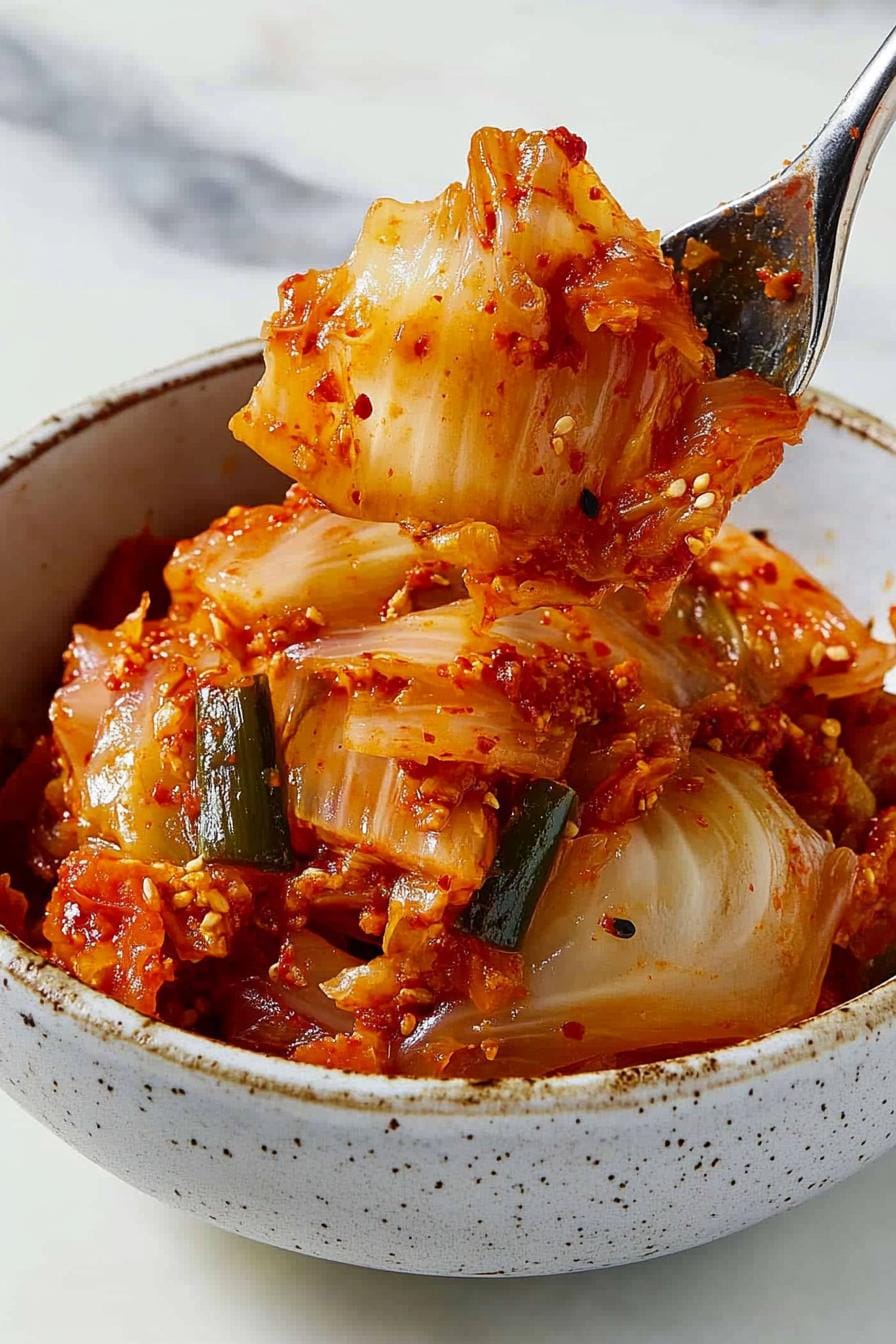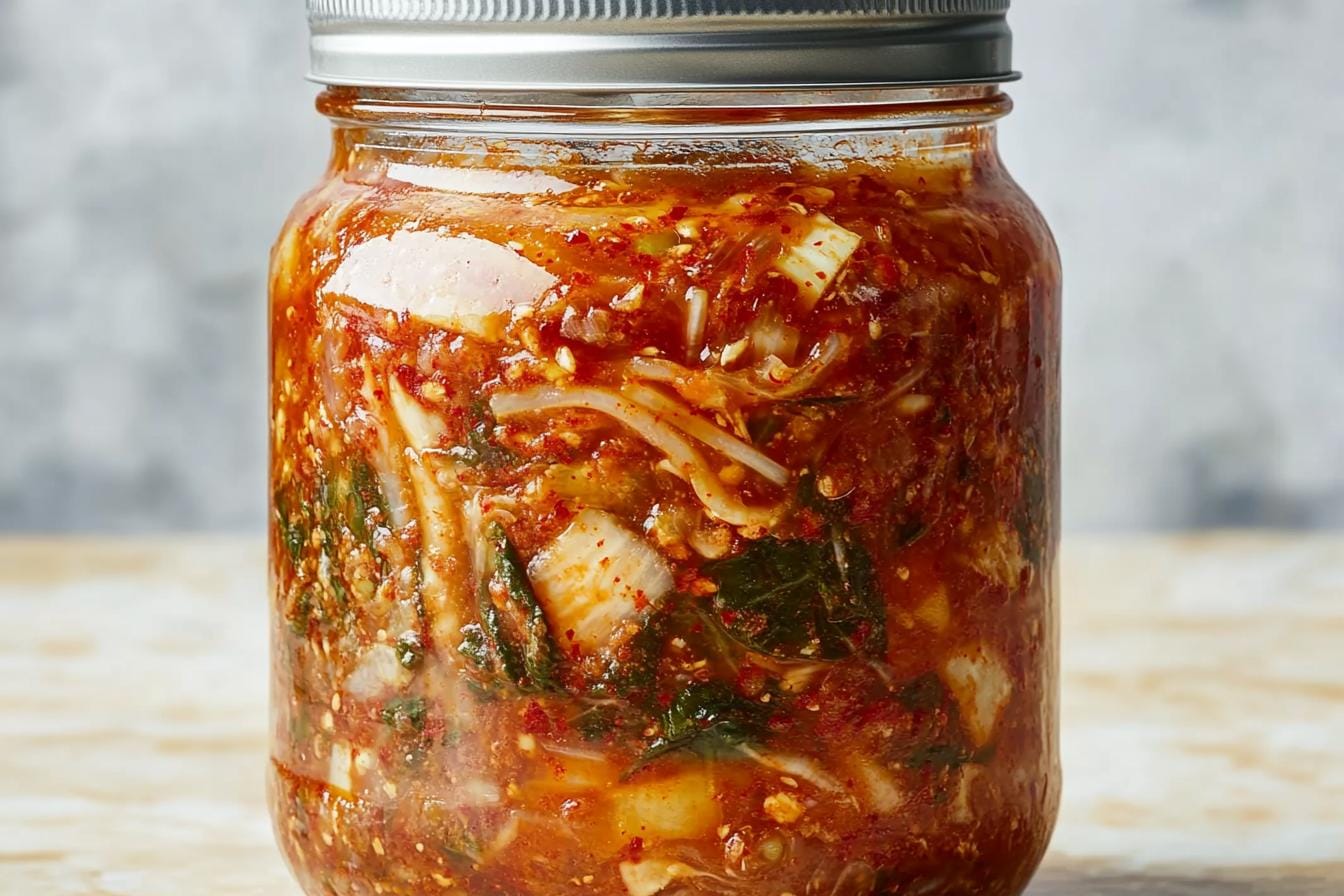Every time I crack open a jar of my homemade kimchi recipe, a fragrant steam rises with a tangy punch. I’ve tested this over three weekends, tweaking the salt soak and spice levels until I captured that silky smooth cabbage with a crisp-tender bite. My first attempt under-salted the leaves and yielded a faint ferment; by the third batch, the ruby-red paste glowed and tasted just right.
Why You’ll Love kimchi recipe
- Bright, crunchy texture adds life to rice bowls or sandwiches.
- Control the heat: adjust gochugaru for gentle warmth or fiery kick.
- Natural fermentation builds gut-friendly cultures.
- Rooted in Korean tradition, it’s a taste of centuries-old culinary heritage.

A Little Background
Last winter, I dusted off my grandmother’s fermentation crock and made this kimchi while a snowstorm rattled the windows. As I rubbed the garlic-ginger paste into the leaves, a nutty toasted scent filled the kitchen, and I knew this batch would bring cozy flavors to cold evenings.
Key Ingredients for kimchi recipe
- Napa cabbage: tender yet sturdy base. Swap bok choy if you’re in a pinch.
- Kosher salt: draws out moisture for pliable leaves; use ½ cup. Table salt works if you cut back by 25%.
- Gochugaru: 2 tablespoons provide the signature scarlet hue and balanced spice.
- Fish sauce: 3 tablespoons for deep umami. Soy sauce is a fine vegetarian substitute.
- Garlic & ginger: 1 tablespoon each, freshly minced and grated for aromatic depth.
- Scallions: 4 stalks, 1-inch pieces, add crisp oniony bite.
How to Make kimchi recipe
- Place 1 medium head of napa cabbage (cut into 2-inch pieces) in a bowl, sprinkle with ½ cup kosher salt, and add enough water to cover. Rest 1 to 2 hours, tossing every 30 minutes, until leaves feel silky smooth and wilted.
- Rinse the cabbage under cold running water three times, then transfer to a colander and let drain for 20 minutes to remove extra brine and avoid an overly salty finish.
- In a separate bowl, mix 2 tablespoons gochugaru, 3 tablespoons fish sauce, 1 tablespoon grated ginger, 1 tablespoon minced garlic, and 1 teaspoon sugar into a paste. Stir in 4 scallions cut into 1-inch pieces. Wearing gloves, massage the paste into the cabbage until every leaf is glossy and fiery red.
- Pack the cabbage into a clean quart jar, leaving 1 inch of headspace. Press down so juices rise above the vegetables, loosely screw on the lid, and ferment at room temperature 1 to 5 days, checking daily for soft bubbling around the edges.

Pro Tips & Troubleshooting
- During testing, I found massaging the paste into every fold of the cabbage for at least 3 minutes delivers an even ferment and vibrant color.
- If your kimchi tastes too salty, a quick rinse under cold water followed by a 24-hour ferment can mellow the brine.
- Stir in shredded radish or julienned carrots for a seasonal crunch and color variation.
- When doubling the batch, maintain the salt-to-cabbage ratio and use a larger jar, keeping a 1-inch headspace.
Storage & Make-Ahead Guide
Once your kimchi shows faint bubbling and a tangy aroma after 2–3 days, tighten the lid and refrigerate. It’ll keep up to 3 weeks on a middle shelf. For longer storage, pack into freezer-safe bags, leaving room for expansion, and freeze up to 2 months. Always use clean utensils to serve. In my fridge, kimchi stored best on the middle shelf with flavors deepening over time. To prep ahead, complete the salting step, then refrigerate the cabbage in an airtight container for up to 24 hours before applying the paste—this helps with safe handling and timing.
Serving Suggestions
Slide scoops alongside bibimbap bowls, top spicy pork tacos, fold into savory pancakes, or swirl into fried rice at the last minute for a pop of tang and color.

Frequently Asked Questions
- How long does homemade kimchi last in the refrigerator? Properly sealed below 40°F, kimchi lasts about 3 to 4 weeks, with tang intensifying over time.
- Can I use table salt instead of kosher salt when making kimchi? Yes—use about 75% of the amount, since table salt grains are finer and pack more densely.
- Do I need a special fermenting jar for kimchi? A clean quart-size mason jar works great; leave 1 inch of headspace and open the lid daily to release gases.
- What if my kimchi is too sour after fermenting? Rinse under cold water to mellow acidity, drain, then refrigerate sooner to slow further fermentation.
- Can I speed up the kimchi fermentation process? Yes—set the jar in a spot around 70°F to reduce ferment time to 1–2 days, but watch closely to prevent overfermentation.
- Is gochugaru the only chili option for kimchi? It’s traditional for its fruity heat, but you can blend in mild chili flakes or Aleppo pepper for a custom spice profile.
Final Thoughts
With this kimchi recipe in your repertoire, you’re set to brighten every meal with a lively tang and crunchy bite. My favorite way is spooned over hot noodles with a drizzle of sesame oil. Give it a try, and share your fermentation adventures in the comments—I can’t wait to hear how your jars turned out!
More Recipes You’ll Love
- Rice Cakes: Quick, Easy, and Versatile Snack – a neutral base to showcase tangy kimchi
- Korean Beef Bowl – traditional pairing with kimchi for balanced flavors
- Fried Rice Recipe – toss kimchi in for a spicy, savory twist
- Potato Salad Recipe – creamy side to mellow kimchi’s heat
Homemade Kimchi
Ingredients
Salting
- 1 head napa cabbage cut into 2-inch pieces
- 0.5 cup kosher salt
- water to cover
Spice Paste
- 1 tablespoon grated ginger
- 4 cloves garlic minced
- 2 tablespoons gochugaru (Korean red pepper flakes)
- 1 teaspoon granulated sugar
- 3 tablespoons fish sauce
- 4 scallions cut into 1-inch pieces
Instructions
Salting
- Cut the napa cabbage into 2-inch pieces. Place in a bowl, sprinkle with kosher salt, add enough water to cover, and let sit for 1–2 hours, tossing every 30 minutes until leaves are pliable.1 head napa cabbage, 0.5 cup kosher salt, water
- Rinse the salted cabbage under cold running water three times. Drain in a colander for 20 minutes.1 head napa cabbage
Spice Paste
- In a bowl, combine grated ginger, minced garlic, gochugaru, sugar, and fish sauce to form a paste. Stir in sliced scallions.1 tablespoon grated ginger, 4 cloves garlic, 2 tablespoons gochugaru (Korean red pepper flakes), 1 teaspoon granulated sugar, 3 tablespoons fish sauce
- Wearing gloves, massage the spice paste into the drained cabbage until every leaf is evenly coated.
- Pack the mixture into a clean quart jar, leaving 1 inch of headspace. Press down to release air, cover loosely, and ferment at room temperature for 1–5 days, checking daily for soft bubbling around the edges.


